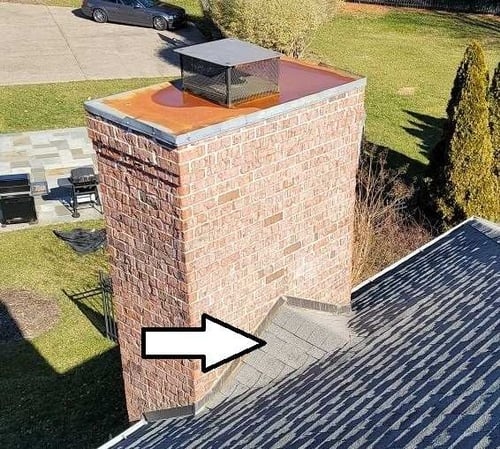Your chimney is one of the largest penetrations that come through your roof. Because of its size, it needs the right materials installed around it to prevent water from getting into your home.
However, your chimney may also need a cricket installed behind it. And no, I’m not talking about the long-legged insects hopping around the yard and chirping at night.
So, what is it? Why do you need it? Does it affect the cost of your roof replacement?
For over 30 years, Bill Ragan Roofing has taken pride in helping homeowners understand everything that goes on their roof. Because of this, I’ll break down everything you need to know about roof crickets.
This article answers the following questions:
- What is a roof cricket?
- What type of roofing material is used on a roof cricket?
- Does a roof cricket impact the cost of your new roof?
- How does a roofer build a roof cricket?
What is a roof cricket?
When it rains, water needs a clear path to the gutters as it comes down your roof. Well, water can’t do this when it gets stuck behind a chimney that’s blocking the path to the gutters.
Instead, water pools behind the chimney and sits on a surface that isn’t meant to have sitting water. This is where a roof cricket comes in.

A roof cricket is a double triangle structure built behind a chimney to divert water around it. It creates a path for water to split down each side of the chimney instead of getting stuck against the flat wall.
While its main purpose is leak prevention, adding one to your roof may also be required. Starting in 2012, the IBC (International Building Code) made a code stating that chimneys over 30 inches wide must have a cricket installed perpendicular to the slope of the roof.
If your roof was replaced before 2012, you’ll need a cricket installed during your next replacement if you have a chimney this wide. However, you can always retrofit a cricket on your current roof if you have continuous problems around the chimney.
What type of roofing material is used on a roof cricket?
When getting a roof cricket, you’ll have to decide what type of roofing material to use for the actual structure. Most homeowners choose the same one that’s already being installed, but it’s completely your decision.

For an asphalt shingle roof, roof crickets usually have the same type of shingle installed on it. However, you can also upgrade it to metal or a membrane.
If you’re on a tighter budget and/or you don't care, I recommend using the same roofing material as the rest of your roof. On the other hand, choosing to upgrade to a different material will add more to the final cost.
Does a roof cricket impact the cost of your new roof?
A roof cricket always impacts the cost of a roof replacement, but installing a new one adds much more than roofing over an existing one. The size of the chimney impacts how much material is required, which impacts material costs.
However, building a new roof cricket is a mini construction project itself. So, there will also be an increase in labor costs associated with a roof replacement.
And remember, upgrading the material increases the cost more than using the same material. But no matter what, you’ll have a cost associated with a roof cricket if your chimney is over 30 inches wide during your roof replacement.
How does a roofer build a roof cricket?
Building a new roof cricket is actually a small project itself, which is why it increases labor and material prices. But how does a roofer build a cricket on your roof?
First, they’ll measure your chimney to decide the size, height, and pitch of the sides. Usually, the pitch on the sides of the cricket will match or be steeper than your roof’s.

Next, a frame is created with 2x4s consisting of a center ridge piece and side pieces at the chosen pitch. The side pieces will be attached to the center ridge piece before securing the frame to the roof decking.

After ensuring it’s firmly in place, you’ll install everything like a mini-roof. Decking (plywood or OSB) is first installed over the sides of the cricket frame.

With the decking in place, underlayment or ice and water shield will be installed over it to provide an additional layer of waterproofing. After that, flashing is installed where it meets the chimney and around the edges (if applicable).

Finally, the roofing material is installed over the cricket and tied into the rest of your roof. This is just a quick breakdown, so make sure to talk to your roofer about how they’ll handle installation.
What other roofing codes do you need to know?
Now you know what a roof cricket is and why you need it. You also learned the type of material installed on it, how it impacts the cost, and how a roofer builds a cricket.
You may not have one if your roof was last replaced before 2012. However, one will be built and installed if you have a chimney that’s over 30 inches wide.
Remember, this is required per building codes in addition to leak prevention around a chimney. However, it’s not the only thing your roof requires to ensure it’s up to code.
The last thing you want is for your home to fail an inspection because something was left off your roof. That’s why I wrote another article breaking down the building codes specific to roofing.
Check out 8 Roofing Codes You Need to Know to understand the different roofing codes and why they’re important.



